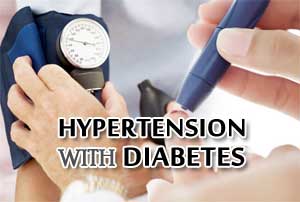- Home
- Editorial
- News
- Practice Guidelines
- Anesthesiology Guidelines
- Cancer Guidelines
- Cardiac Sciences Guidelines
- Critical Care Guidelines
- Dentistry Guidelines
- Dermatology Guidelines
- Diabetes and Endo Guidelines
- Diagnostics Guidelines
- ENT Guidelines
- Featured Practice Guidelines
- Gastroenterology Guidelines
- Geriatrics Guidelines
- Medicine Guidelines
- Nephrology Guidelines
- Neurosciences Guidelines
- Obs and Gynae Guidelines
- Ophthalmology Guidelines
- Orthopaedics Guidelines
- Paediatrics Guidelines
- Psychiatry Guidelines
- Pulmonology Guidelines
- Radiology Guidelines
- Surgery Guidelines
- Urology Guidelines
ADA Guidelines for treating Hypertension with Diabetes

American Diabetes Association has released guidelines for treatment of Hypertension in Patients with Diabetes which have been published in Diabetes Care. According to new Guidelines, there is strong evidence from clinical trials and meta-analyses which supports targeting blood pressure reduction to at least <140/90 mmHg in most adults with diabetes. Lower blood pressure targets may be beneficial for selected patients with high cardiovascular disease risk if they can be achieved without undue burden, and such lower targets may be considered on an individual basis.
DEFINITIONS, SCREENING, AND DIAGNOSIS
Recommendations
Blood pressure should be measured at every routine clinical care visit. Patients found to have an elevated blood pressure (≥140/90 mmHg) should have blood pressure confirmed using multiple readings, including measurements on a separate day, to diagnose hypertension. B
All hypertensive patients with diabetes should have home blood pressure monitored to identify white-coat hypertension. B
Orthostatic measurement of blood pressure should be performed during initial evaluation of hypertension and periodically at follow-up, or when symptoms of orthostatic hypotension are present, and regularly if orthostatic hypotension has been diagnosed. E
BLOOD PRESSURE TARGETS
Recommendations
Most patients with diabetes and hypertension should be treated to a systolic blood pressure goal of <140 mmHg and a diastolic blood pressure goal of <90 mmHg. A
Lower systolic and diastolic blood pressure targets, such as <130/80 mmHg, may be appropriate for individuals at high risk of cardiovascular disease if they can be achieved without undue treatment burden. B
TREATMENT
Lifestyle Management
Recommendation
For patients with systolic blood pressure >120 mmHg or diastolic blood pressure >80 mmHg, lifestyle intervention consists of weight loss if overweight or obese; a Dietary Approaches to Stop Hypertension (DASH)-style dietary pattern including reduced sodium and increased potassium intake; increased fruit and vegetable consumption; moderation of alcohol intake; and increased physical activity. B
Pharmacologic Antihypertensive Treatment
Recommendations
Patients with confirmed office-based blood pressure ≥140/90 mmHg should, in addition to lifestyle therapy, have timely titration of pharmacologic therapy to achieve blood pressure goals. A
Patients with confirmed office-based blood pressure ≥160/100 mmHg should, in addition to lifestyle therapy, have prompt initiation and timely titration of two drugs or a single-pill combination of drugs demonstrated to reduce cardiovascular events in patients with diabetes. A
Treatment for hypertension should include drug classes demonstrated to reduce cardiovascular events in patients with diabetes: ACE inhibitors, angiotensin receptor blockers (ARBs), thiazide-like diuretics, or dihydropyridine calcium channel blockers. Multiple-drug therapy is generally required to achieve blood pressure targets (but not a combination of ACE inhibitors and ARBs). A
An ACE inhibitor or ARB, at the maximum tolerated dose indicated for blood pressure treatment, is the recommended first-line treatment for hypertension in patients with diabetes and urine albumin-to-creatinine ratio ≥300 mg/g creatinine (A) or 30–299 mg/g creatinine (B). If one class is not tolerated, the other should be substituted. B
- For patients treated with an ACE inhibitor, ARB, or diuretic, serum creatinine/estimated glomerular filtration rate and serum potassium levels should be monitored. B
- Patients with resistant hypertension who are not meeting blood pressure targets on conventional drug therapy with three agents, including a diuretic, should be referred to a certified hypertension specialist
PREGNANCY
Recommendations
Pregnant women with diabetes and preexisting hypertension or mild gestational hypertension with systolic blood pressure <160 mmHg, diastolic blood pressure <105 mmHg, and no evidence of end-organ damage do not need to be treated with pharmacologic antihypertensive therapy. E
In pregnant patients with diabetes and preexisting hypertension who are treated with antihypertensive therapy, systolic or diastolic blood pressure targets of 120–160/80–105 mmHg are suggested in the interest of optimizing long-term maternal health and fetal growth. E
There is strong evidence from clinical trials and meta-analyses which supports targeting blood pressure reduction to at least <140/90 mmHg in most adults with diabetes. Lower blood pressure targets may be beneficial for selected patients with high cardiovascular disease risk if they can be achieved without undue burden, and such lower targets may be considered on an individual basis. In addition to lifestyle modifications, multiple medication classes are often needed to attain blood pressure goals. ACE inhibitors, ARBs, dihydropyridine CCBs, and thiazide-like diuretics have been demonstrated to improve clinical outcomes and are preferred for blood pressure control. For patients with albuminuria, an ACE inhibitor or ARB should be part of the antihypertensive regimen.
For further reference log on to :
De Boer IH, Bangalore S, Benetos A, et al. Diabetes and Hypertension: A Position Statement by the American Diabetes Association. Diabetes Care. 2017 Sep;40(9):1273-84. http://care.diabetesjournals.org/content/40/9/1273

Disclaimer: This site is primarily intended for healthcare professionals. Any content/information on this website does not replace the advice of medical and/or health professionals and should not be construed as medical/diagnostic advice/endorsement or prescription. Use of this site is subject to our terms of use, privacy policy, advertisement policy. © 2020 Minerva Medical Treatment Pvt Ltd